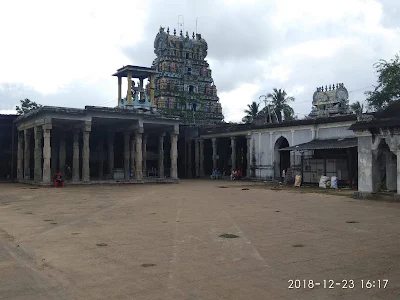Agniswarar Temple, Kanjanur – Sukran ( Venus)
The Agniswarar Temple is a Shiva temple in the village of Kanjanur, 18 kilometres north-east of Kumbakonam. The presiding deity is Sukra (Venus). The main idol in the temple is that of "Agniswarar" or shiva lingam. In concordance with the Saivite belief that Shiva is all-pervading, Sukra is believed to be located within the stomach of the idol of Shiva. The lingam is also a Bramha lingam as Lord bramha himself has prayed to Lord shiva here. There is no separate shrine for Sukran. The name Agniswarar is derived from the lore that Lord agni prayed to lord shiva here.
The temple was built by the Medieval Cholas and renovated by the kings of the Vijayanagara empire Kings. The temple has a 5-tier Rajagopuram surrounded by two Praharams (closed precincts of a temple). Legend is that Siva blessed Parasara muni(sage) here with cosmic dance. It is believed that Shiva appeared in the form of Sukra to propitiate himself off the dosha of Sukran.
During vamana Avathar, lord vishnu took the form of a small brahmin boy and asked Bali for three paces of land. Bali’s Guru Sukracharya had a premonition that the boy was Vishnu and asked him to deny the boon. The virtuous king Bali against his Guru’s advice, wanted to grant the wish of the Lord. Sukracharya took the form of a bee and hid in the mouth of the Kamandalu for preventing the water to flow for Bali to donate the three paces of land. When water did not flow from the kamandalam, Vishnu pricked Sukracharya with a Darbha grass, who lost his eye, and had to come out in pain. His wish fulfilled, Vamana took his huge form(Vishwaroopam) and measured out the Earth and the Sky, and as the 3rd step, placed his foot on Bali’s Head ,blessing him.
Sukracharya however was angry with Vishnu, and cursed him. It is belived that Vishnu prayed to Shiva at Kanjanur, where he was relieved of the curse. Shiva not only blessed Vishnu here, he promised to remain and bless those who came with prayers to Sukran.
Kanjanur is one of the nine Navagraha sthalas located in the Cauvery Delta region dedicated to planet Venus, called Sukra. Unlike other Navagraha temples, the main deity, Agniswarar in the form of lingam depicts Lord Sukra.

Comments
Post a Comment